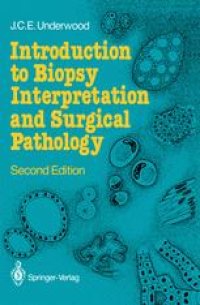
Ebook: Introduction to Biopsy Interpretation and Surgical Pathology
- Tags: Pathology, Cell Biology, General Surgery
- Year: 1987
- Publisher: Springer-Verlag London
- Edition: 2
- Language: English
- pdf
Preface to the Second Edition Since publication of the first edition, continuing developments in histopathology have motivated the inclusion of four new chapters: cytology, immunohistology, quality control and assessment, and the autopsy. The increasing use of cytology in clinical practice and advances in techniques and diagnostic interpretation justify the devotion of more space than formerly to this important topic. Immunohistology now merits a separate chapter because it has a status beyond that of being just another "special stain" and there are certain aspects of technique and interpretation that are peculiar to it. Quality control and assessment in histopathology are very topical and important now that greater attention is being paid to cost effectiveness and the auditing of many aspects of clinical practice. The autopsy is an integral part of the professional life of a histopathologist and, though it lacks the immediate clinical impact of the biopsy diagnosis, it nevertheless constitutes an important activity in all hospitals; without detailing dissection techniques I have provided some information and guidance about the autopsy which I believe will be useful to trainees and of interest to others. The remainder of the book has been thoroughly revised and updated, and illustrations and tables added where experience has shown that the text is insufficient. Sheffield, October 1986 J. C. E. Underwood Preface to the First Edition This book is primarily addressed to the needs of the trainee histopathologist.
This is the second edition of the comprehensive and succinct account of basic principles and techniques of diagnostic histopathology, aimed at trainees in this discipline. Following a general introduction, the book gives a description of basic histopathological methods, such as tissue sampling and histological stains. Special techniques, including frozen sections, cytopathology, immunohistology, electron microscopy, and quantitive methods, are described in separate chapters. The methods of interpreting histological images and common causes of diagnostic difficulty are extensively illustrated. This new edition has been thoroughly revised and contains four new chapters, including quality control in histopathology and the autopsy. It is directly relevant to the activities of histopathologists and surgical pathologists, and will also be of value to physicians and surgeons in various specialties who use biopsies in clinical diagnosis.
This is the second edition of the comprehensive and succinct account of basic principles and techniques of diagnostic histopathology, aimed at trainees in this discipline. Following a general introduction, the book gives a description of basic histopathological methods, such as tissue sampling and histological stains. Special techniques, including frozen sections, cytopathology, immunohistology, electron microscopy, and quantitive methods, are described in separate chapters. The methods of interpreting histological images and common causes of diagnostic difficulty are extensively illustrated. This new edition has been thoroughly revised and contains four new chapters, including quality control in histopathology and the autopsy. It is directly relevant to the activities of histopathologists and surgical pathologists, and will also be of value to physicians and surgeons in various specialties who use biopsies in clinical diagnosis.
Content:
Front Matter....Pages i-xiv
Diagnostic Histopathology....Pages 1-16
Macroscopy, Microscopy and Sampling....Pages 17-38
The Use of Stains....Pages 39-54
Immunohistology....Pages 55-68
Interpretation of Histological Appearances....Pages 69-96
Cytology....Pages 97-109
Borderline Lesions, Pseudomalignancy and Mimicry....Pages 111-135
Rapid Frozen Section Diagnosis....Pages 137-147
Diagnostic Electron Microscopy....Pages 149-160
Quantitative Methods....Pages 161-176
Reporting and Classification of Biopsy Diagnoses....Pages 177-186
Quality Assessment and Control....Pages 187-194
The Autopsy....Pages 195-205
Back Matter....Pages 207-217
This is the second edition of the comprehensive and succinct account of basic principles and techniques of diagnostic histopathology, aimed at trainees in this discipline. Following a general introduction, the book gives a description of basic histopathological methods, such as tissue sampling and histological stains. Special techniques, including frozen sections, cytopathology, immunohistology, electron microscopy, and quantitive methods, are described in separate chapters. The methods of interpreting histological images and common causes of diagnostic difficulty are extensively illustrated. This new edition has been thoroughly revised and contains four new chapters, including quality control in histopathology and the autopsy. It is directly relevant to the activities of histopathologists and surgical pathologists, and will also be of value to physicians and surgeons in various specialties who use biopsies in clinical diagnosis.
Content:
Front Matter....Pages i-xiv
Diagnostic Histopathology....Pages 1-16
Macroscopy, Microscopy and Sampling....Pages 17-38
The Use of Stains....Pages 39-54
Immunohistology....Pages 55-68
Interpretation of Histological Appearances....Pages 69-96
Cytology....Pages 97-109
Borderline Lesions, Pseudomalignancy and Mimicry....Pages 111-135
Rapid Frozen Section Diagnosis....Pages 137-147
Diagnostic Electron Microscopy....Pages 149-160
Quantitative Methods....Pages 161-176
Reporting and Classification of Biopsy Diagnoses....Pages 177-186
Quality Assessment and Control....Pages 187-194
The Autopsy....Pages 195-205
Back Matter....Pages 207-217
....